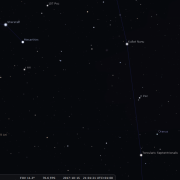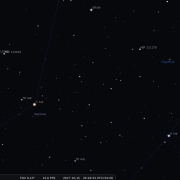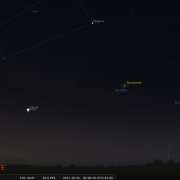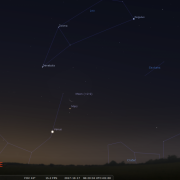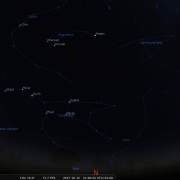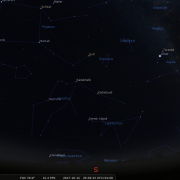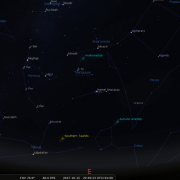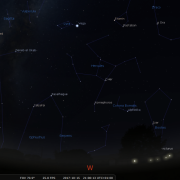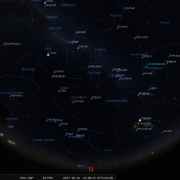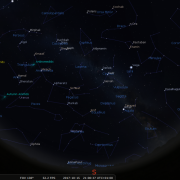In this month's Sky Notes:
Planetary Skylights
Evening

 Saturn gradually edges toward the west horizon throughout October, but remains readily observable all month. The rings are favourably orientated, but you will have to wait for those steadier ‘seeing’ moments to fully appreciate this wonderful spectacle. View on the 24th around 18:30h when a Crescent Moon lies above Saturn.
Saturn gradually edges toward the west horizon throughout October, but remains readily observable all month. The rings are favourably orientated, but you will have to wait for those steadier ‘seeing’ moments to fully appreciate this wonderful spectacle. View on the 24th around 18:30h when a Crescent Moon lies above Saturn.
 At Magnitude +5.65 Uranus should be easily visible in a pair of binoculars, however to discern its very small grey/green disk a telescope will be required. The planet lies over in the east toward the bottom of the ‘V’ in Pisces, not far above Torcularis Septentrionalis, however the best way to locate it will be by using Sheratan and Mesarthim in Aries (the crooked leg of the ram) and sighting down five times the distance between them, and then up one. Hopefully you should spot ‘Herschel’s planet’ The moon lies 4 degrees below on the 6th
At Magnitude +5.65 Uranus should be easily visible in a pair of binoculars, however to discern its very small grey/green disk a telescope will be required. The planet lies over in the east toward the bottom of the ‘V’ in Pisces, not far above Torcularis Septentrionalis, however the best way to locate it will be by using Sheratan and Mesarthim in Aries (the crooked leg of the ram) and sighting down five times the distance between them, and then up one. Hopefully you should spot ‘Herschel’s planet’ The moon lies 4 degrees below on the 6th
 Neptune is located to the south east in the constellation of Aquarius, but you will require a telescope to identify it. It resides below the asterism known as the ‘water jar’ not far beneath Lamda Aquarii. Through a telescope Neptune resembles a tiny blue/grey disk. The Moon lies lower left on the 3rd.
Neptune is located to the south east in the constellation of Aquarius, but you will require a telescope to identify it. It resides below the asterism known as the ‘water jar’ not far beneath Lamda Aquarii. Through a telescope Neptune resembles a tiny blue/grey disk. The Moon lies lower left on the 3rd.
Morning


 Venus and Mars reside in the eastern dawn sky. View around 06:00h at the start of October, when Venus is unmistakeable, a brilliant object seven degrees or so above the horizon. Mars resides just below and left. During the first week of the month Venus tracks downwards, whilst Mars gains a little in altitude, the two passing closest on the 6th. This will be a splendid sight in a telescope. Thereafter the two go their separate ways, Mars up, Venus down. But view again on the 17th and 18th when a Crescent Moon passes by both planets.
Venus and Mars reside in the eastern dawn sky. View around 06:00h at the start of October, when Venus is unmistakeable, a brilliant object seven degrees or so above the horizon. Mars resides just below and left. During the first week of the month Venus tracks downwards, whilst Mars gains a little in altitude, the two passing closest on the 6th. This will be a splendid sight in a telescope. Thereafter the two go their separate ways, Mars up, Venus down. But view again on the 17th and 18th when a Crescent Moon passes by both planets.
Meteors & Comets

The Orionids (Oct 16- 27) are the months most reliable shower, peaking this year on Oct 21/22. Like the Eta Aquarids that occur in May, Orionids are associated with Comet Halley, but are more favourable for northern hemisphere observers due to the radiant being situated high in the S by early morning hours. Orionids are swift, often producing persistent trains. Peak rates can exceed 20 per hour.
The weak Piscid shower has three peak dates, Oct 13th being the optimum one. Observed rates are little better than sporadic levels - around 3-7 per hour. Piscid meteors are often slow, of long duration, but not very brilliant. Strong moonlight will interfere this year.
Perhaps the most interesting shower is the Giacobinids or Draconids (Oct 6 -10th peaking on the 8th) which are associated with the periodic comet Giacabini- Zinner (6yrs) The shower is very erratic, but can produce outbursts of activity. There is apparently evidence to suggest that this may occur this year The BAA suggest observing between 11pm and 3am on the evening of the 8th, although strong moonlight will be present in this period.
October 2017 Sky Charts
|
Looking North
Mid-October - 21:00h |
Looking South |
|
Looking East
Mid-October - 21:00h |
Looking West
Mid-October - 21:00h |
| Northern Aspect Mid-October - 21:00h |
Southern Aspect Mid-October - 21:00h |
Additional Image Credits:
- Planets and Comets where not otherwise mentioned: NASA
- Sky Charts: Stellarium Software
- Log in to post comments

